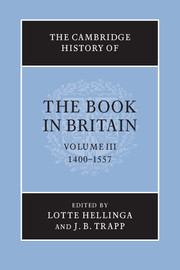Book contents
- Frontmatter
- Introduction
- 1 Literacy, books and readers
- TECHNIQUE AND TRADE
- COLLECTIONS AND OWNERSHIP
- READING AND USE OF BOOKS
- I BOOKS FOR SCHOLARS
- 14 The humanist book
- 15 University libraries and book-sellers
- 16 Text-books in the universities: the evidence from the books
- 17 Text-books: a case study – logic
- II PROFESSIONS
- III THE LAY READER
- Appendix
- List of abbreviations
- Bibliography
- Photo credits
- General index
- Index of manuscripts
- Bibliographic index of printed books
- Plate Section"
- References
14 - The humanist book
from I - BOOKS FOR SCHOLARS
Published online by Cambridge University Press: 28 March 2008
- Frontmatter
- Introduction
- 1 Literacy, books and readers
- TECHNIQUE AND TRADE
- COLLECTIONS AND OWNERSHIP
- READING AND USE OF BOOKS
- I BOOKS FOR SCHOLARS
- 14 The humanist book
- 15 University libraries and book-sellers
- 16 Text-books in the universities: the evidence from the books
- 17 Text-books: a case study – logic
- II PROFESSIONS
- III THE LAY READER
- Appendix
- List of abbreviations
- Bibliography
- Photo credits
- General index
- Index of manuscripts
- Bibliographic index of printed books
- Plate Section"
- References
Summary
Introduction
The (h)umanista of the fifteenth-century Italian universities, where the name was coined, was a teacher of the studia humanitatis, who based his course of instruction on the grammar and rhetoric, the poetry and history, and the ethical writings of classical Antiquity. He characterized the education he offered as ‘liberal’, worthy of a free man, as opposed to the narrowly professional and personally deforming current university disciplines of medicine, law and theology.
The activities typical of the humanist in this strict sense were the editing and exposition of Latin and Greek texts, and the translation of Greek into Latin, with the aim of recovering and reviving ancient knowledge and ancient eloquence, ancient purity of diction and ancient techniques of argument. This involved him (female humanists of this kind were all but non-existent, or at least have left no legacy) in the search for texts of classical authors unknown or neglected in the Middle Ages, or for fuller and better texts of such authors than had been used by his medieval predecessors. Such Latin texts, or Greek texts newly translated into Latin, he transcribed and disseminated in a reformed, legible, upright script which he believed he was modelling on ancient Roman handwriting. The basis for the ‘roman’ type of the early Italian printers, it was in fact imitating twelfth-century letter forms. The sloped, ‘italic’ letter, developed about the same time, entered printing a quarter-century later than the ‘roman’, being first used by Aldus Manutius for classical texts in 1501.
Keywords
- Type
- Chapter
- Information
- The Cambridge History of the Book in Britain , pp. 283 - 315Publisher: Cambridge University PressPrint publication year: 1999
References
- 3
- Cited by

